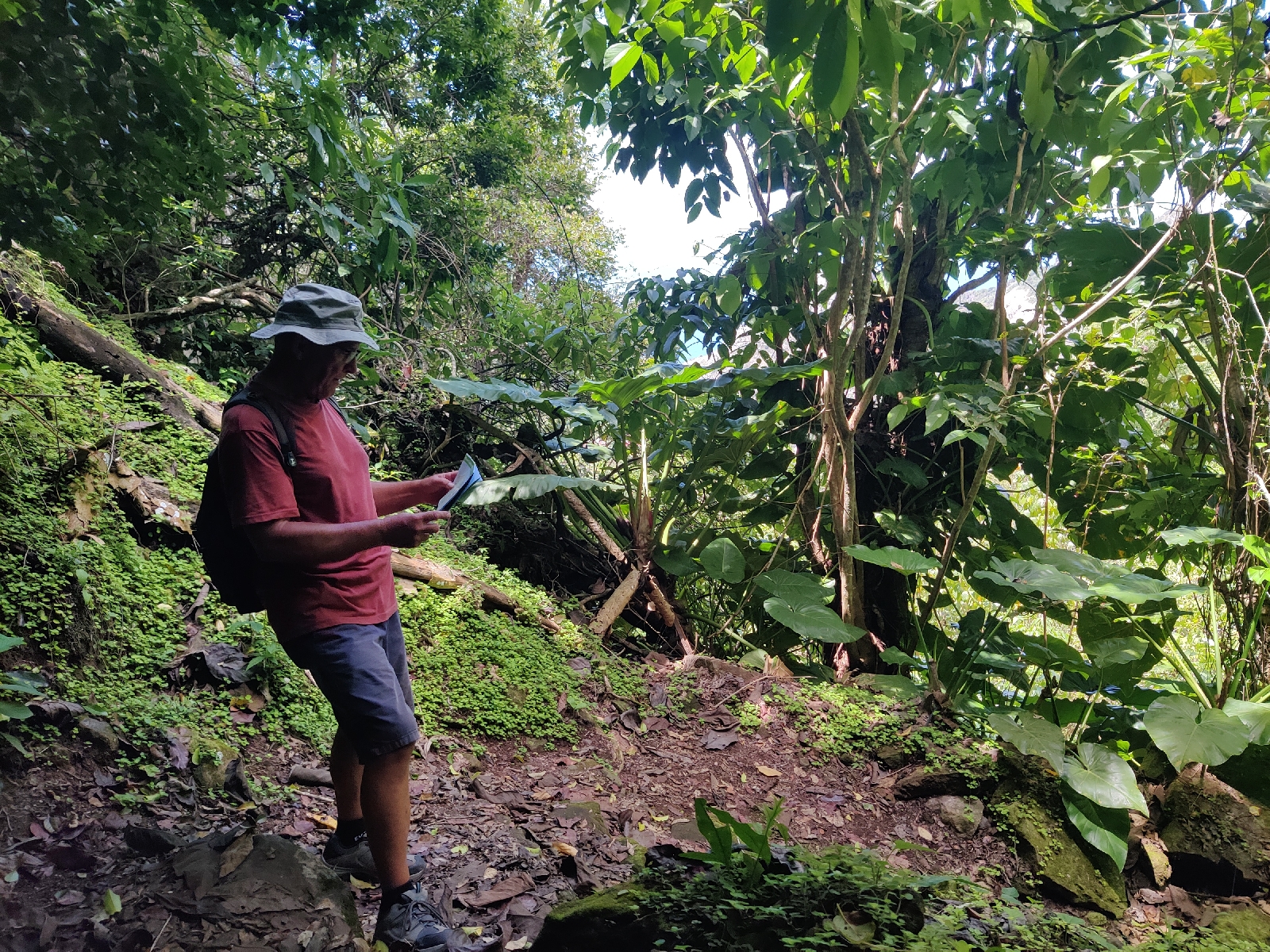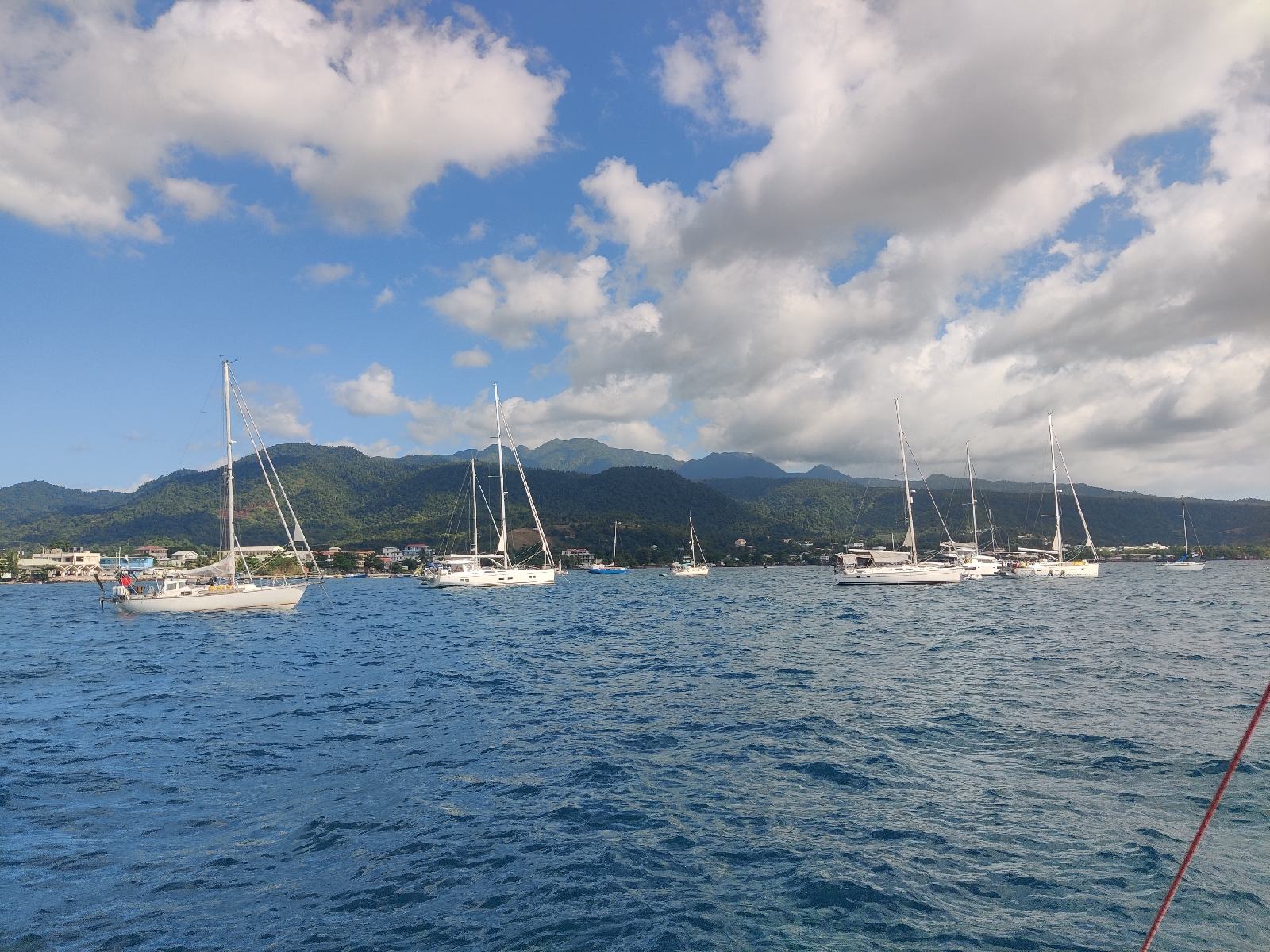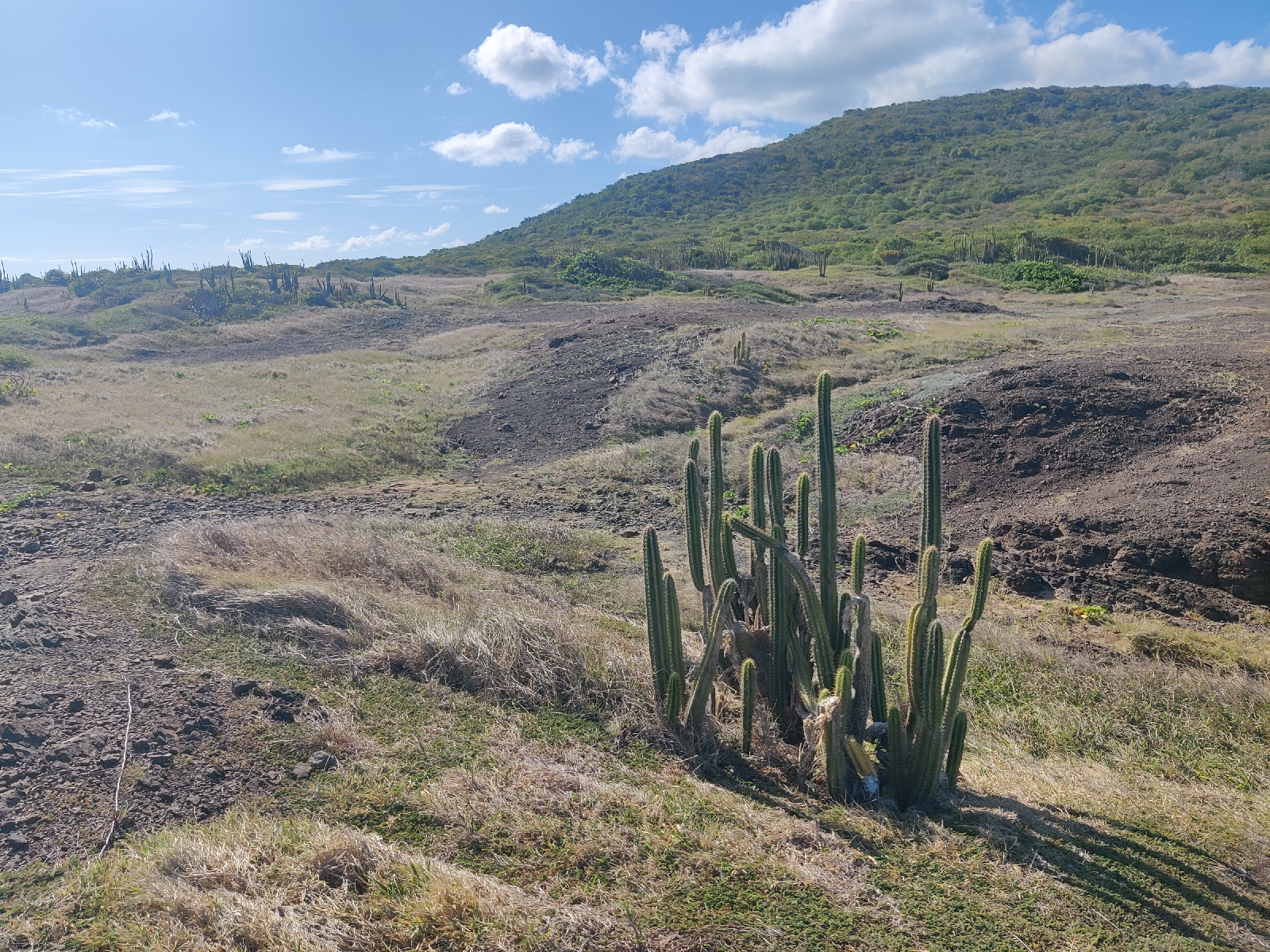When we arrived in Portsmouth, St Rupert's Bay, Dominica on Friday 5th April, Lasse and Birgitte on Aura were already there. Titti4 with Jan and Elli on board, arrived on the evening of Wednesday 10th and Johannes and Olena on Laura, arrived on Thursday 11th.
Aura left on Saturday 13th.
On Sunday 14th April, Bonny departed. Titti4 was due to leave the next day but Laura would be staying a few more days to explore the island some more.
All these comings and goings were marked with a flurry of "hello" and "goodbye" gatherings. We kicked things off by hosting Lasse and Birgitte for dinner on the evening of our arrival. Mick cooked his 'famous' Spaghetti Bolognese.
On Sunday 7th the crews of Bonny and Aura attended the local beach barbecue with the rum punch getting the better of some! On Wednesday 10th, having recovered sufficiently from the excesses of Sunday, Aura hosted the first goodbye party, for the crews of Bonny and Titti4.
The next day, Thursday, was Elli's birthday and I awoke to find Titt4 'dressed overall' to mark the occasion and very smart she looked too. Jan and Elli therefore had a further excuse to host yet another party for us all, including Johannes, Laura having arrived earlier that evening. Unfortunately, Olena was poorly and unable to join us.
The next day, Friday, Mick and I hosted the final goodbye party on board Bonny...
On Sunday morning the 14th April, we said goodbye to Jan and Elli and then went for coffee on board Laura with Johannes and Olena (who happily, was now restored). After lingering too long over coffee, we said our goodbyes, returned to Bonny and prepared to leave and eventually weighed anchor at around 1230, leaving the remaining half of our impromptu fleet, Laura and Titti4 behind in the bay.
Will we see any of them again? We had made great friends with everyone and it was sad to say goodbye in the knowledge, that with the exception of Jan and Elli, we probably won't - at least not in the next few years.
Lasse and Birgitte are bound eventually, for Trinidad in a couple of weeks, where they will leave Aura for the Hurricane season and return home to Sweden for the summer. They will return to Aura in the Autumn to continue their wanderings and may well circumnavigate.
Johannas and Olena are also still in the relatively early stages of a round the world odyssey.
Bonny is of course heading north, with this summer's destination being Nova Scotia, where I hope to leave her for the Autumn/Winter and return home by air before continuing the journey after a family holiday there early next summer.
We do expect to see Jan and Elli again fairly soon however, because they too are bound for Nova Scotia. They will probably catch up with us in Saint Martin from where we both intend to depart for Bermuda before heading for truly northern waters.
We left Dominica with the intention of sailing to Montserrat. We had a beautiful sail across the gap between Dominica and Guadalupe with a few spells of motoring during the night when the hills of Guadalupe stole our wind. Conditions freshened as expected after leaving Guadalupe behind and we had a cracking sail to Montserrat, arriving off the south east of the island before dawn on Monday.
It was quite an eery experience. We saw the dark shape of the island emerge whilst it was still dark, but there wasn't a single light to be seen. The southern half of the island is still a no-go area following the volcano eruption in 2011. As we sailed up the east coast, lights emerged and then dawn broke - very quickly, but so too, did the weather. Suddenly we were being lashed by a violent squall of 30+ knots, and driving rain. One minute I was at the mast in the blackness of night, struggling to reef in the midst of the squall, the next, dawn had arrived. Admittedly, it was a dawn more reminiscent of the Thames Estuary than the Carribbean. Slate grey with squalls now plainly visible all around. With two reefs now in both main and genoa we continued on our way, anticipating a dry-out, a rest and a hearty meal at the anchorage on the north west of the island just a couple of hours away.
Oh foolish boy! As we approached the anchorage with just two yachts in attendance and rolling heavily, it was clear that a heavy swell was making its way in and would make for a most uncomfortable stay.
Neither of us fancied that prospect so we turned round and headed... It took some considerable time to decide where. The conditions seemed to abate as we drew away from the island, convincing me that it was the island creating the squalls as it rudely disrupted the flow of the trades. The sea was of course still up, a nasty combination especially with the wind free. There's not enough wind to stop the main boom crashing about as the boat rolls. So we shook out the reefs and rigged a preventer on the boom. No sooner had we completed that than another more violent squall struck. For a few minutes we were screaming along to windward on our ear under a full genoa, as I once again put two reefs in the main. Then we reefed the genoa (I should have reefed it first) and sanity was (sort of) restored.
Where to go? Given the conditions we met at Montserrat, a sheltered anchorage was a priority. The nearest was Antigua about 20 miles away, but that would be a dead beat up-wind in pretty gruesome conditions. The anchorages on the south of St Kitts seemed to offer a reasonable alternative. They were fourty miles away, but we'd have the wind off our quarter and should get there in eight hours or so.
With the wind from the quarter or further aft, the mainsail blankets the genoa, causing lots of crashing about as the sheets slacken and tighten in response to the rolling of the boat. So we doused the mainsail and continued under deeply reefed genoa - still making 6+ knots!
The foul weather continued for most of the day. As we approached Nevis, the visibility took a dive and for a while was very poor. It really did feel like home. However, the wind eased as we gained the lee of the islands and so I shook out the reefs in the genoa.
After an hour or so groping our way down the south coast of Nevis in the murk, the visibility improved and we could see our destination, White House Bay, to the south of Basseterre, a few miles off.
A great deal of faffing about, then followed. We didn't plan to go ashore. Having visited the island before in 2017 we wanted to spend our remaining time in the Carribbean visiting islands we had not seen before. However, St Kitts' Customs authorities have a reputation for being rather fussy and overzealous and so when I read the note on my Navionics chart for our preferred anchorage - with its dire warning of hefty fines being issued to boats that anchor anywhere other than the Port of Entry Anchorage before checking in - I got cold feet and we headed over to the official anchorage. This took an hour of motoring. We arrived to find a swell running which was almost as bad as that we encountered at Montserrat. "Bugger it, we'll risk the fine" I thought and so we headed back towards White House Bay.
Two hours later, around 1600 we finally dropped the hook next to a very smart, purposeful looking vessel flying the OCC house flag. This was notable on two fronts. Firstly, it was pristine and put our very tatty specimen to shame...
Secondly, hardly any OCC members fly a house flag, they nearly all fly a burgee (triangular), not from the mast head which is the proper place for a burgee, but from the spreaders, which is most definitely not the proper place.
Then I noticed fluttering from her mast head, a burgee, that of the Royal Cruising Club. That explained it. The RCC is a most august organisation. Established in around 100 years ago it has amongst its ranks many famous yachts people who have undertaken demanding voyages in the most challenging parts of the world from the Arctic to Antarctica and some have even visited both regions on the same cruise.
Perhaps the most famous of RCC members was one William (Bill) Tillman, who in the 1960s/70s led a series of sailing and climbing expeditions on his venerable Pilot Cutter, "Mischief", to the Arctic, Argentina and the islands of the Southern Ocean. Bill survived two shipwrecks in the Arctic. The first when his beloved "Mischief" was lost after arguing with the ice and the second when her replacement, another Pilot Cutter, was lost only a couple of years later in similar circumstances. Bill was eventually also lost at sea in his twilight years, leading one last expedition to the Southern Ocean; an end which whilst tragic, seemed only fitting.
But back to the present. When a skipper is a member of more than one sailing club, etiquette requires they fly the burgee of the oldest club at the mast head, above all other flags. Our neighbour therefore clearly knew his flags!
Why belong to two clubs though? Well, the RCC is, in sailing terms, a somewhat rarified organisation, with a fairly small, by invitation only, membership. As a consequence, there just aren't many of them to fratanise with. So, if you like making new friends as you wander around the oceans, you need to be part of a bigger community.
With a membership of 1000+ and growing the OCC fits the bill perfectly. This year, it celebrates its 70th birthday and so there are even more excuses to party than normal. To be a full member you need to have completed a non-stop qualifying passage of at least 1000 miles on a sailing boat of no more than 60 feet long; so you've got to be pretty keen.
Mick and I qualified in 2016 on our crossing from Cape Verde to Martinique. When established, 70 years ago, in the days of small wooden boats (a 30 foot boat was big in those days) and sextants and paper charts, an Ocean passage of 1000 miles, really was a major achievement. With GPS, chart plotters, watermakers and increasingly, onboard internet and of course, far bigger boats, today's members have a rather easier life.
The enthusiastic waves from our new neighbour's crew, were rather more than a polite greeting - we must have met before. Even without our disgraceful OCC house flag, we had clearly been recognised. I couldn't see a boat name and so checked our AIS. It was "Henry". I had last seen her and her youthful skipper, Will, in Pasito Blanco.
Within half an hour, Will came over in his dinghy with his pal Pete, to invite is on board Henry for drinks. How could we refuse? Henry was custom built in Poland from aluminium to a Van Der Statt design and fitted out in Falmouth by Will and his parents. On board we also met Dessa, Pete's partner. We enjoyed a very pleasant evening, being plied with drinks and catching up on each others travel stories.
I couldn't come close to Will's however and it soon became apparent why the RCC burgee flew from Henry's mast head. Will's day job is as Skipper on the British Antarctic Survey's, "Sir David Attenborough" and he had only recently returned from a trip to the bottom of the world. He had therefore missed out on the Atlantic crossing on Henry, which his parents had undertaken without him.
Henry was heading for Newport where Will will park her up before re-joining the Sir David Attenborough in June for another venture to the Antartic!
Mick and I needed a lift back to Bonny and so we all piled into Henry's dinghy and carried on the session back on Bonny. Afterwards I was just able to stay awake for long enough to cook and eat dinner!
We needed an early start in the morning to be assured of making our next stop in daylight. So I dragged myself out of bed in response to the alarm st 0500 and we were underway by 0630.
A delightful sail to Saba, 40 miles to the north west, followed and after speaking to the helpful and friendly Harbour Master at Fort Baai (the only port of entry) over the VHF, we carried on to Ladder Baai on the south west coast, where we were assured, we would have a more comfortable night.
We were to check-in at 0800 the following morning.




























